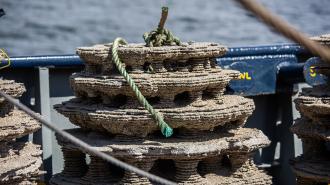The Danish clean energy company Ørsted and WWF Denmark (the nature nonprofit, not, like, Thor-themed pro wrestlers) have installed 3D-printed reefs around the Anholt Offshore Wind Farm — one of the largest wind farms in the world.
The artificial reefs are meant to help restore the biodiversity of the region — the waters between Sweden and Denmark — which is an important cod fishery and is facing a historically low stock of cod.

Each faux reef weighs up to half a ton, their tiered structure laced with hollows connecting the layers and allowing space for fish and other forms of marine life to hide and thrive, with their outer surface providing space for other animals to anchor to.
The 3D-printed reefs, created by Italian firm D-Shape, are the first of their kind in Danish waters, and they will bolster other artificial reefs made from boulders installed during Anholt’s construction in 2013.
“We must give nature and wildlife a hand, while trying to solve our climate crisis by expanding our renewable energy production at the same time,” Bo Øksnebjerg, WWF Denmark’s secretary general, said. “To solve the nature crisis, we must leave nature in better shape than before.”
The dozen 3D-printed reefs were placed in the frigid waters of the Kattegat, a part of the North Sea bounded by the main peninsula of Denmark, Jutland, and Sweden, where cod patrol the waters and keep a complex ecosystem in check.
WWF Denmark and Ørsted hope the 3D-printed reefs will work in conjunction with the 24 boulder reefs that were in the wind farm.
The Anholt Offshore Wind Farm’s 111 turbines produce enough power for over a million Danes’ needs.
We’d love to hear from you! If you have a comment about this article or if you have a tip for a future Freethink story, please email us at [email protected].






